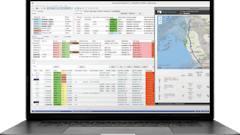
Transportation management systems (TMS) provide valuable tools for e-commerce brands and retailers to manage the ever-increasing costs of shipping throughout the supply chain. Today’s volatile global supply chain environment requires intelligent analysis and solutions to help companies chart the most cost effective and reliable course.
Let’s start with a global perspective on inbound logistics, i.e. getting products from manufacturers across the world to domestic retail and wholesale outlets.
Inbound logistics
For companies manufacturing overseas, the inbound logistics challenges have never been more acute. There have been notable disruptions in supply chain routes during the pandemic, followed by security considerations and a lack a water in the Panama Canal. Now the threat of tariffs has become a real issue for many companies and contingency planning is in full swing.
Brands and retailers necessarily must be creative and flexible when evaluating the many choices for getting products from overseas to retailers in America. Leading international logistics companies offer a variety of options, including:
o Door-to-door import freight services
o Ocean freight
o Air freight
o Customs brokerage and coordination of LCL, FCL
These options are followed by domestic drayage, trucking, and rail to get products into the domestic fulfillment operations. Manufacturer to consumer (M2C) options are also available from some of the major producers across the Pacific.
Domestic TMS considerations
Closer to home, retailers must integrate stable and reliable TMS services across the domestic delivery market. Let’s consider some of the primary delivery strategies and the attributes of a quality TMS platform. Why is this important? Customer expectations have never been higher.
- 22% of e-commerce customers abandon their cart if the shipping time takes too long.
- 48% will abandon their cart if additional costs, such as delivery, are too high.
These factors are too critical to ignore. Let’s review the essentials of today’s environment for TMS services.
Outbound TMS services
American consumers have been spoiled and conditioned for immediate gratification with their online shopping options. Same-day delivery has gone from a luxury to a common occurrence in the past five years. These are great developments for consumers and forced an organic improvement in TMS technologies and services. Last-mile carriers could be counted on one hand in 2020 and now there are dozens of choices.
A fully integrated TMS can help retailers make good decisions across the delivery spectrum. The objective is to ensure optimal delivery times at the lowest cost via rate and method shopping. Integrating across multiple carrier options is a requirement.
Regional distribution
Leveraging fulfillment operations across the country provides shipping cost savings and faster delivery options. Integrated TMS platforms make these solutions readily available to benefit your brand and the customer experience. Retailers can manage the inventory levels in support of split distribution to optimize the delivery timeframe and set reliable expectations. Putting your products nearer the customer reduces shipping time and expense for everyone.
Rate shopping
Rate shopping solutions optimize the best transportation rate with the best method of shipping. With access to multiple carriers, a quality TMS compares rates and services across a variety of different shipping providers. Ultimately, the TMS chooses the most cost-effective option based on factors such as transit time, service level, accessorial fees, and delivery promise.
Transportation analytics
Providing comprehensive reports and valuable analytics on shipping activities is paramount to a successful TMS. These insights enable ecommerce retailers to identify trends, analyze costs, and make data-driven decisions to optimize shipping strategies. By identifying areas for improvement, they can implement cost-saving measures and enhance their supply chain performance.
Always having real-time visibility and total control of your business, from anywhere on any device, should be the standard. Watch your orders being fulfilled live, create orders, edit orders, cancel orders, manage returns – all on demand, without having to call someone.
Branded tracking
The major shipping carriers spend hundreds of millions of dollars on advertising their own brands and pull consumers to the tracking pages on their websites. tracking software allows a company to own that UX and build the brand. Turn customers’ routine of tracking packages into an opportunity to bring them back to your website versus going elsewhere to check on their order. Integrated branded tracking pages offer a unique opportunity to create additional sales opportunities and create lifetime value.
Return transportation considerations
A comprehensive TMS generates reports and provides valuable analytics on all shipping activities, including returns. These insights enable ecommerce retailers to identify trends, analyze costs, and make data-driven decisions to optimize shipping strategies. Why is this important?
o 55% of shoppers have abandoned a cart because the return policy didn’t offer a convenient return option.
o 91% of shoppers are more likely to shop with a merchant that offers box-free, label-free returns and immediately initiated refunds.
o 73% of shoppers say a poor returns experience impacts their decision to shop with a merchant again.
Benefits of a powerful TMS for returns processing:
o Software can be optimized with WMS, TMS and returns partners.
o Provides options for consumers
o Maximum revenue retention
o Brands retain clients to encourage exchanges over refunds
o Trim return shipping costs by tapping into a network that consolidates multi-vendor returns
o Enhance sustainability and best practices for reusing materials, merging returns volume and cutting down on waste.

![Pros To Know 2026 [color]](https://img.sdcexec.com/mindful/acbm/workspaces/default/uploads/2025/08/prostoknow-2026-color.mduFvhpgMk.png?auto=format%2Ccompress&bg=fff&fill-color=fff&fit=fill&h=100&q=70&w=100)







![Pros To Know 2026 [color]](https://img.sdcexec.com/mindful/acbm/workspaces/default/uploads/2025/08/prostoknow-2026-color.mduFvhpgMk.png?ar=16%3A9&auto=format%2Ccompress&bg=fff&fill-color=fff&fit=fill&h=135&q=70&w=240)









